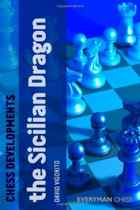Chess Developments — The Sicilian Dragon
David Vigorito

Chess Developments: The Sicilian Dragon by International Master David Vigorito is part of a new series by Everyman that is a break from traditional opening books that attempt to cover all variations in a comprehensive fashion. Recognizing that the explosion of opening theory in the past decade has made such books all but impossible to write and even harder to use, this series focuses instead on the most critical lines of the past five years.
This selectivity can be seen in the variations Vigorito has chosen to cover. The reader will not find lesser lines like the Levenfish (6.f4), Classical (6.Be2) or Fianchetto variations (6.g3) where Black has no existing theoretical difficulties. Nor will they find Black tries in the Yugoslav Attack with …Qa5 which however exciting have proved wanting against precise play. Instead Vigorito covers the following critical variations:
Part I: 9 Bc4 Bd7
1 Soltis Variation: 10.0-0-0 Rc8 11.Bb3 Ne5 12.h4 h5 9
2 Modern Variation: 10.0-0-0 Rc8 11.Bb3 Ne5 12.Kb1 58
3 Topalov Variation: 10.0-0-0 Rc8 11.Bb3 Nxd4 89
4 Chinese Variation: 10.0-0-0 Rb8 116
5 Accelerated Variation: 10.Bb3 Nxd4 11Bxd4 b5 141
Part II: 9.0-0-0 and 9.g4 165
6 9.0-0-0 d5 10 exd5 167
7 9.0-0-0 d5 10 Qe1 206
8 9.0-0-0 d5 10 Kb1 225
9 9.0-0-0 Nxd4 and 9…Bd7 255
10 9.g4
While Vigorito provides quality coverage and interesting new ideas, what makes this book particularly valuable are his observations. For example after 1.e4 c5 2.Nf3 d6 3.d4 cxd4 4.Nxd4 Nf6 5.Nc3 g6 6.Be3 Bg7 7.f3 Nc6 8.Qd2 0-0 9.0-0-0 Nxd4 10.Bxd4 Be6 11.Kb1 (!) He writes:
“This is the real test of Blacks system. Other moves are possible of course, but this move essentially gains a tempo and is clearly best. [Note: while 11.Nd5 (Grischuk – Nakamura, Moscow 2012) was successful for White, it appears to have been at least in part for its surprise value.]
One surprisingly tough nut for White to crack has been the Dragon/Accelerated Dragon variation 1.e4 c5 2.Nf3 d6 3.d4 cxd4 4.Nxd4 Nf6 5.Nc3 g6 6.Be3 Bg7 7.f3 Nc6 8.Qd2 0-0 9.Bc4 Bd7 10.Bb3 Nxd4 11.Bxd4 b5. Accelerated Dragon players should take note that in this book the line is analyzed exclusively via the Dragon move order and not 1.e4 c5 2.Nf3 Nc6 3.d4 cxd4 4.Nxd4 g6 5.Nc3 Bg7 6.Be3 Nf6 7.Bc4 0-0 8.Bb3 d6 9.f3 Bd7 where White has the additional option 10.h4 which is not covered here. This doesnt necessarily lead to independent play but the Accelerated Dragon fan who wishes to stay out of the main lines of the Dragon might have appreciated some coverage of the critical 10 …a5 11.a4 Nxd4 12.Bxd4 Be6 (a position known to favor White with his h-pawn on h2. With it on h4 matters are considerably less clear).
This very small caveat aside, Chess Developments: The Sicilian Dragon can be warmly recommended to Dragon aficionados from 1800 on up. Vigoritos reputation as a first rate author continues to grow.
